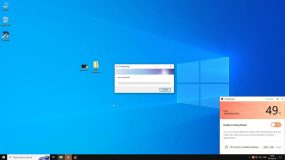What Is Dllhost.exe?
Dllhost.exe, also known as COM Surrogate, is a legitimate Windows system process essential for enabling certain web and system services to function smoothly. If you’ve ever opened Task Manager and noticed dllhost.exe running in the background, that’s completely normal.

Executable files like dllhost.exe carry out vital functions for your applications. They act as the engine behind your apps by executing the code and processes the software needs to run. Without these files, most applications wouldn’t even launch.
But because they are executable, these files are also targeted by malware developers who disguise malicious programs under names like dllhost.exe. That’s where many users begin to experience the dllhost.exe system error, especially if a file is missing, corrupt, or infected.
🛡 Tip: To check if dllhost.exe is being misused or infected, run a deep scan with Outbyte AVarmor — it can detect and remove hidden threats while keeping your system protected from future infections.
Why Do Dllhost.exe Errors Happen?
The most common culprit behind dllhost.exe errors is malware infection. Viruses can replace or damage the original dllhost.exe file, creating instability or preventing it from running altogether.
Other reasons include:
- Registry errors associated with
dllhost.exe - File corruption
- Incomplete Windows updates
- Issues with installed software
- Faulty hardware or memory problems
When dllhost.exe can’t operate correctly, you’ll often be blocked from launching applications or completing basic tasks.
Common Dllhost.exe Error Messages
Here are some of the messages you may encounter if dllhost.exe is not working properly:
- dllhost.exe has encountered a problem and needs to close.
- dllhost.exe Application Error
- Cannot find dllhost.exe
- dllhost.exe is not running
- dllhost.exe is not a valid Win32 application
- dllhost.exe not found
- dllhost.exe failed
- Error starting program: dllhost.exe
- Faulting Application Path: dllhost.exe
These errors might show up while launching an app, installing or uninstalling software, during Windows updates, or even when booting or shutting down your PC. Taking note of when the error occurs can help you determine the best solution.
How to Fix Dllhost.exe Application Error
The dllhost.exe application error is something you’ll want to resolve promptly to avoid recurring system issues. Below are several methods you can try—each tackles a different possible root cause.
Scan Your Computer for Malware or Virus Infection
Since dllhost.exe is a known disguise for malware, the first step is always to rule out infection.
Use your preferred antivirus tool to conduct a complete scan of your system. After detection, quarantine or remove any flagged threats. It’s also helpful to use a PC repair utility like Outbyte PC Repair to ensure no corrupted system files or leftover malware fragments remain, especially in hidden folders or temp directories.
Roll Back to a Previous Restore Point
If dllhost.exe errors started recently, using System Restore can bring your system back to a state before the issue began—without affecting your personal files.
Here’s how:
- Click Start, then type
Recoveryin the search bar. - Select Recovery from the results.
- Click Open System Restore, then choose Next.
- Pick a restore point created before the error started.
- Follow the on-screen prompts to complete the process.
This method reverses any system-level changes that might have triggered the dllhost.exe error.
Run Windows System File Checker
If any system files related to dllhost.exe are damaged or missing, the System File Checker (SFC) can help restore them.
Follow these steps:
- Click Start and type
cmd. - Right-click Command Prompt, then choose Run as administrator.
- Click Yes when prompted.
In the window, type:sfc /scannow
- Press Enter and wait for the scan to finish.
SFC will attempt to repair any corrupted system files it finds.
Perform a DISM Scan
If the System File Checker didn’t solve the issue, use the DISM tool (Deployment Imaging and Servicing Management) to dig deeper and fix Windows image files.
Steps:
- Open Command Prompt as administrator.
Type each command below and press Enter after each one:Dism /Online /Cleanup-Image /ScanHealth
Dism /Online /Cleanup-Image /CheckHealth
Dism /Online /Cleanup-Image /RestoreHealth
- Wait for the process to complete, then close Command Prompt.
DISM is more advanced than SFC and can repair deeper system issues.
🔧 Fix Tip: Outdated or faulty drivers can sometimes interfere with system repairs. Outbyte Driver Updater helps ensure all your essential drivers are current, minimizing conflicts during recovery processes.
Check and Install Updates for Windows
Sometimes, the dllhost.exe system error is triggered by an outdated OS. Installing the latest updates can correct this.
To check for updates:
- Click Start > Settings
- Go to Update & Security
- Click Check for updates on the right panel
- Install any available updates, then restart your computer
Keeping Windows updated ensures system stability and compatibility with software and drivers.
Summary
Dllhost.exe plays an essential role in the functioning of various Windows services. If you encounter a dllhost.exe application error or dllhost.exe system error, don’t ignore it—these issues can prevent you from using critical software.
Start by checking for malware, then try system repair tools like SFC and DISM, or roll back your PC to a previous restore point. With the right troubleshooting steps, you can get your system back in shape and avoid recurring disruptions.
Facing more system errors? These fixes can help:
How to Fix the Microsoft Error Code 0x426-0x0
How to Fix Outlook Error 0x800CCC0E
FAQs
What is dllhost.exe and is it safe?
Yes, dllhost.exe is a legitimate Windows process known as COM Surrogate. It’s safe unless it’s been replaced by malware.
Why do I keep getting dllhost.exe application errors?
It could be due to corrupted system files, malware, registry issues, or outdated Windows components.
Can I delete dllhost.exe?
No, dllhost.exe is a core system file. Deleting it may lead to serious system instability.
How can I tell if dllhost.exe is malware?
Check its file location via Task Manager. If it’s not located in C:\Windows\System32, it could be malicious.
Do I need to run both SFC and DISM scans?
It’s recommended to run SFC first. If the issue persists, follow it up with DISM for a deeper fix.





